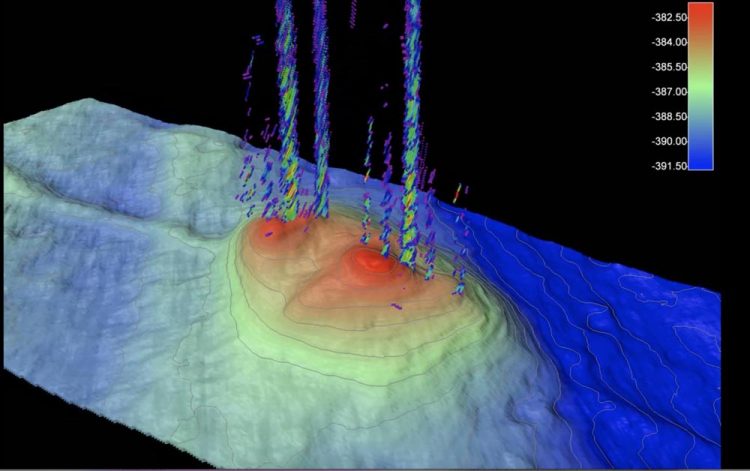Domes of frozen methane may be warning signs for new blow-outs

500m wide and 10m high, the methane domes on the Arctic Ocean floor are containing huge amounts of methane. Illustration: Pavel Serov/CAGE Credit: Pavel Serov/CAGE
“Every year we go back to the dome area with our research vessel, and every year I am anxious to see if one of these domes has become a crater,” says lead author of the study Pavel Serov, PhD candidate at CAGE at UiT The Arctic University of Norway.
These domes are the present-day analogue to what scientists think preceded the craters found in the near-by area, which were recently reported in Science. The craters were formed as the ice sheet retreated from the Barents Sea during the deglaciation some 12.000 years ago.
At the time, 2km thick ice-cover loaded what now is the ocean floor with heavy weight. Under the ice sheet the methane became stored as hydrate, a solid form of frozen methane.
“We believe that one step before the craters are created, you get these domes. They are mounds of hydrates, technically we call them gas hydrate pingos. They are hydrate and methane saturated relics of the last ice-age. They haven't collapsed yet. And the reason is a matter of narrow margins” states Serov.
20 meters from the brink of collapse
The dome area is situated on the Arctic Ocean floor just north of the craters. It is deeper, but not by much. The domes are found some 20 meters deeper. Essentially the height of the Buckingham Palace keeps these methane domes from blowing out the gas and becoming craters.
“Hydrates are stable in low temperatures and under high pressure. So, the pressure of 390 meters of water above is presently keeping them stabilised. But the methane is bubbling from these domes. This is actually one of the most active methane seep sites that we have mapped in the Arctic Ocean. Some of these methane flares extend almost to the sea surface” says Serov.
He is reluctant to speculate as to how much methane may be released into the ocean should the domes collapse entirely and abruptly. It is not possible to predict when it may happen either. But every sediment core collected in the area is full of hydrates.
This is actually the first time that domes such as these have been found outside of the permafrost areas.
More stable than in permafrost
However unstable these domes on the Arctic Ocean floor may be, they are still more stable than the pingos found in sub- sea permafrost in Canadian and Russian Arctic.
“The gas hydrate pingos in permafrost are formed because of the low temperatures. But the water-depth that supports gas hydrates in sub-sea permafrost is only 40 to 50 meters. There is no significant pressure there to keep them in check. Sub-seabed permafrost is deteriorating constantly and quickly” notes Serov.
Even though they are more stable than the permafrost pingos, the Barents Sea domes are on the limit of their existence.
“A relatively small change in the water temperature can destabilise these hydrates fairly quickly. We were actually very lucky to observe them at this point. And we will probably be able to observe significant changes to these domes during our lifetime.”
Media Contact
More Information:
http://www.uit.noAll latest news from the category: Earth Sciences
Earth Sciences (also referred to as Geosciences), which deals with basic issues surrounding our planet, plays a vital role in the area of energy and raw materials supply.
Earth Sciences comprises subjects such as geology, geography, geological informatics, paleontology, mineralogy, petrography, crystallography, geophysics, geodesy, glaciology, cartography, photogrammetry, meteorology and seismology, early-warning systems, earthquake research and polar research.
Newest articles

Combatting disruptive ‘noise’ in quantum communication
In a significant milestone for quantum communication technology, an experiment has demonstrated how networks can be leveraged to combat disruptive ‘noise’ in quantum communications. The international effort led by researchers…

Stretchable quantum dot display
Intrinsically stretchable quantum dot-based light-emitting diodes achieved record-breaking performance. A team of South Korean scientists led by Professor KIM Dae-Hyeong of the Center for Nanoparticle Research within the Institute for…

Internet can achieve quantum speed with light saved as sound
Researchers at the University of Copenhagen’s Niels Bohr Institute have developed a new way to create quantum memory: A small drum can store data sent with light in its sonic…




















